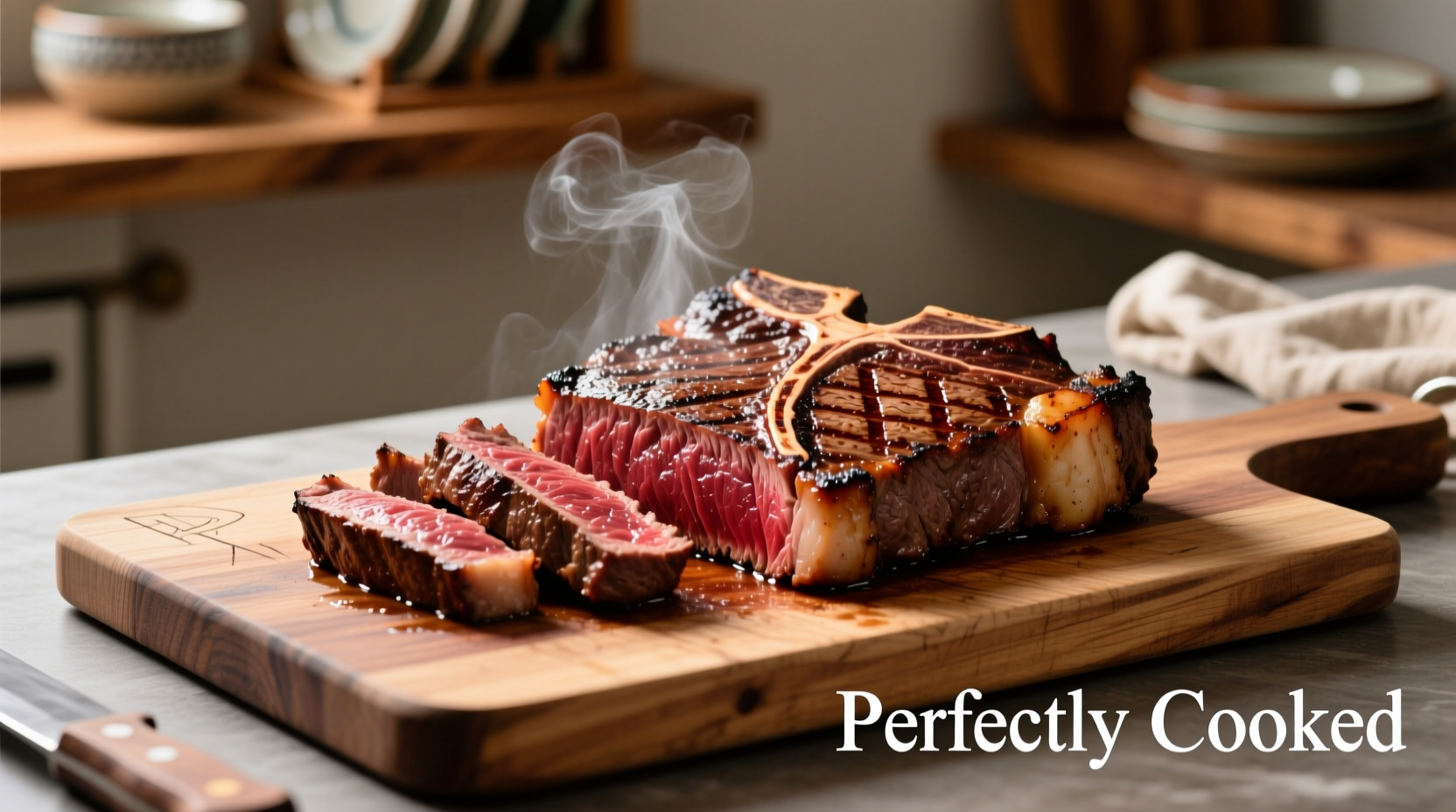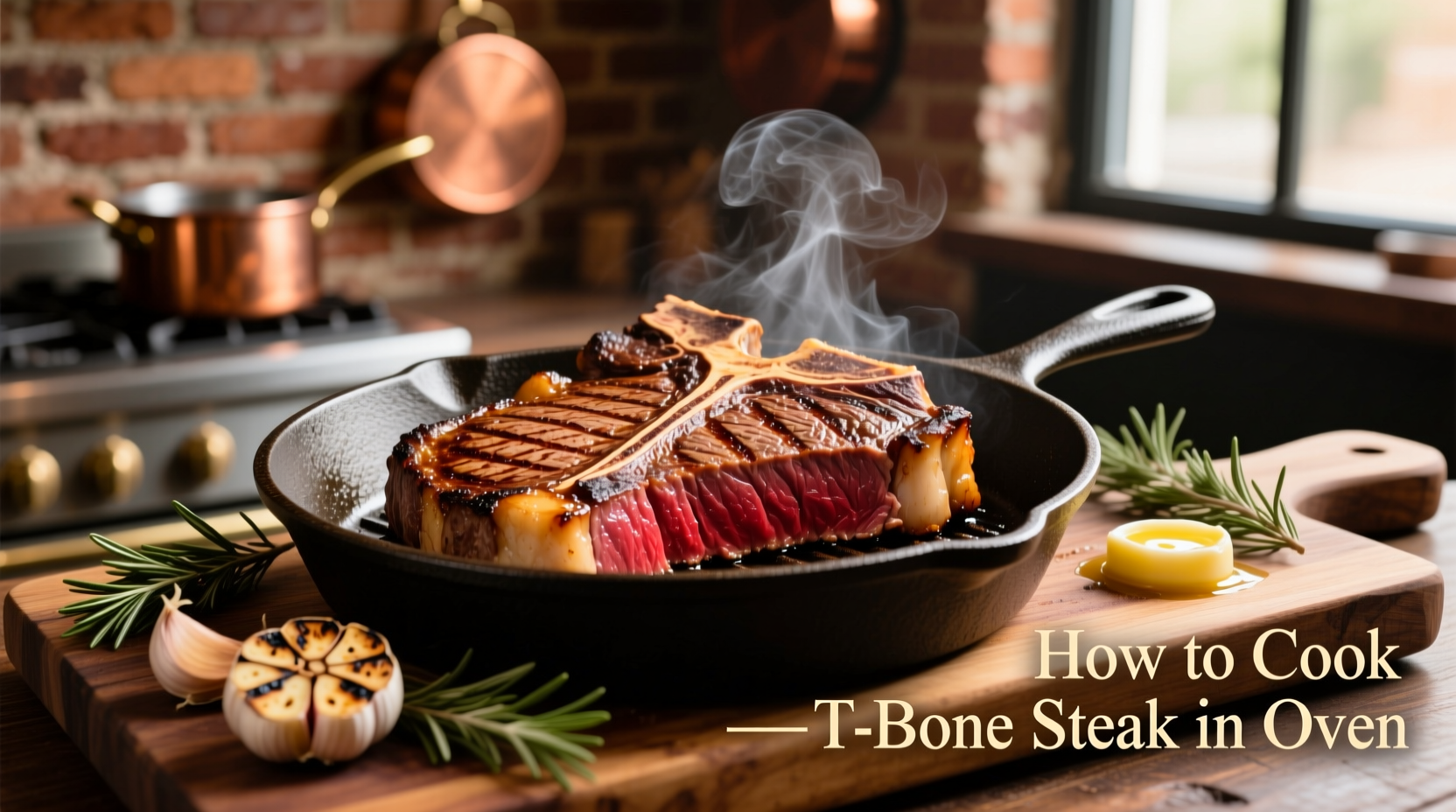Perfectly cook a T-bone steak in the oven by preheating to 400°F (204°C), seasoning generously, searing for 2-3 minutes per side, then finishing in the oven for 8-12 minutes depending on thickness and desired doneness. Always use a meat thermometer to ensure accurate results—125°F for rare, 135°F for medium-rare. Let rest 10 minutes before slicing for maximum juiciness.
Why Oven Cooking Delivers Restaurant-Quality T-Bone Steaks at Home
Cooking T-bone steak in the oven combines precise temperature control with professional searing techniques—a method preferred by chefs for consistent results. Unlike grilling, which depends on weather conditions, or stovetop-only methods that risk uneven cooking, the oven provides steady radiant heat that penetrates thick cuts evenly while preserving the T-bone's signature marbling.
Essential Equipment Checklist
Before starting, gather these critical tools:
- Oven-safe cast iron or stainless steel skillet (avoid non-stick)
- Instant-read meat thermometer (digital recommended)
- Heavy-duty tongs (no piercing required)
- Wire rack for resting
- Aluminum foil
Selecting Your T-Bone Steak: What Butchers Won't Tell You
Not all T-bones are created equal. Look for these quality indicators:
- Thickness: Minimum 1.5 inches (3.8 cm) for proper oven cooking
- Marbling: Fine white fat streaks throughout the meat (not just on edges)
- Color: Bright cherry red, not brown or gray
- Grade: USDA Prime preferred, but Choice works well with proper technique
| Cooking Method | Best For Thickness | Temperature Control | Crust Quality |
|---|---|---|---|
| Oven + Sear | 1.5+ inches | Excellent | Professional-grade crust |
| Grill Only | 1-1.5 inches | Variable (weather dependent) | Good but uneven |
| Stovetop Only | Under 1 inch | Poor (hot spots) | Burnt exterior, raw interior |
Preparation: The 30-Minute Secret Restaurants Use
Proper preparation makes or breaks your T-bone:
- Temperature equalization: Remove steak from refrigerator 30 minutes before cooking. Cold centers cause uneven cooking.
- Drying: Pat thoroughly with paper towels—moisture prevents proper searing.
- Seasoning: Generously apply coarse kosher salt (1 tsp per pound) and freshly ground black pepper. For enhanced flavor, add 1 minced garlic clove and 1 tsp dried thyme per steak.
Precision Temperature Guide: Your Doneness Roadmap
USDA food safety guidelines confirm beef is safe at 145°F, but culinary experts recommend lower temperatures for optimal texture and flavor. Remember that carryover cooking will raise internal temperature 5-10°F during resting.
| Doneness | Oven Finish Time* | Target Temp | Final Temp After Rest |
|---|---|---|---|
| Rare | 8-10 minutes | 120-125°F | 125-130°F |
| Medium-Rare | 10-12 minutes | 130-135°F | 135-140°F |
| Medium | 12-14 minutes | 140-145°F | 145-150°F |
*For 1.5-inch thick steaks at 400°F. Add 2 minutes per additional 0.5 inch thickness.
Step-by-Step Oven Cooking Process
1. Preheat and Prepare
Preheat oven to 400°F (204°C) with rack positioned in the center. Place empty skillet inside during preheating—this ensures immediate searing when steak hits the pan.
2. Searing for Perfect Crust
Carefully place seasoned steak in hot skillet. Sear undisturbed for 2-3 minutes until deep brown crust forms. Flip and sear opposite side 2-3 minutes. For thicker cuts, sear edges by holding steak vertically with tongs for 30-60 seconds per side.
3. Oven Finishing Technique
Transfer skillet directly to preheated oven. Cook according to thickness and desired doneness, checking temperature 2 minutes before estimated finish time. For extra flavor, add 2 tbsp butter, 2 garlic cloves, and fresh rosemary sprigs during the last 2 minutes of cooking.
4. The Critical Resting Phase
Transfer steak to wire rack, tent loosely with foil, and rest for 10 minutes minimum. This allows juices to redistribute—skipping this step causes up to 40% juice loss when cutting, according to research from the Culinary Institute of America.

Avoid These 3 Costly Oven Steak Mistakes
- Mistake #1: Using the wrong pan—Non-stick pans can't reach high enough temperatures for proper searing. Cast iron retains heat best for oven-to-table cooking.
- Mistake #2: Guessing doneness—Relying on touch or time alone leads to inconsistent results. Always use a digital thermometer for accuracy within 1°F.
- Mistake #3: Cutting too soon—Resting isn't optional. The American Meat Science Association confirms proteins need 5-10 minutes to reabsorb juices after cooking.
When Oven Cooking Isn't Ideal: Context Boundaries
While excellent for most home cooks, oven cooking has limitations:
- Steaks under 1 inch thick: Better suited for stovetop-only cooking to prevent overcooking
- Extreme outdoor conditions: When ambient temperature is below freezing, oven provides more consistent results than grill
- Specialty equipment: If you own a precision sous vide setup, consider combining methods (sous vide first, then oven finish)
Perfect Pairings: Serving Your T-Bone Steak
Enhance your masterpiece with these classic accompaniments:
- Sauces: Chimichurri, béarnaise, or simple garlic-herb butter
- Sides: Roasted asparagus, garlic mashed potatoes, or creamed spinach
- Wine: Bold Cabernet Sauvignon or Malbec complements the rich flavor
When slicing, cut perpendicular to the bone against the grain for maximum tenderness. The T-bone's unique structure means the strip and tenderloin sections require slightly different cutting angles—adjust as you move across the steak.
Frequently Asked Questions
Can I cook frozen T-bone steak in the oven?
No, cooking frozen steak in the oven produces uneven results with gray bands near the surface. Thaw steaks completely in the refrigerator for 24 hours before cooking for optimal texture and food safety. The USDA Food Safety and Inspection Service recommends never cooking large cuts of meat from frozen due to potential bacterial growth in the danger zone (40°F-140°F).
Why does my oven-cooked T-bone steak turn out tough?
Toughness typically results from either under-resting (less than 8 minutes) or overcooking beyond 150°F internal temperature. T-bone contains connective tissue that requires proper temperature management. Always use a meat thermometer and allow full 10-minute rest period. The Culinary Institute of America's research shows proteins continue cooking for several minutes after removal from heat.
What's the best oven temperature for T-bone steak?
400°F (204°C) provides the ideal balance between rapid cooking and controlled heat penetration. Lower temperatures (325°F) risk overcooking the exterior before the center reaches desired temperature, while higher temperatures (450°F+) may burn the crust before the interior cooks through. This temperature recommendation aligns with professional kitchen standards documented by the American Culinary Federation.
How do I fix an overcooked T-bone steak?
While prevention is best, salvage overcooked steak by thinly slicing against the grain and serving with a flavorful sauce like chimichurri or compound butter. The American Meat Science Association suggests that moist-heat applications (like brief immersion in warm broth) can help restore some moisture to overcooked beef, though texture cannot be fully recovered.











 浙公网安备
33010002000092号
浙公网安备
33010002000092号 浙B2-20120091-4
浙B2-20120091-4